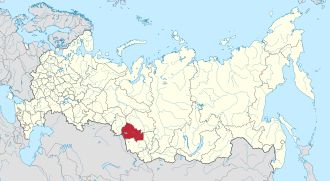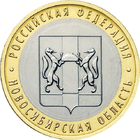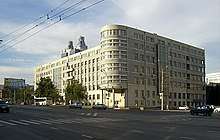Novosibirsk Oblast
Novosibirsk Oblast (Russian: Новосиби́рская о́бласть, Novosibirskaya oblast) is a federal subject of Russia (an oblast) located in southwestern Siberia. Its administrative and economic center is the city of Novosibirsk. The population was 2,788,849 as of the 2018 Census.[14]
Novosibirsk Oblast | |
|---|---|
| Новосибирская область | |
| Anthem: [1] | |
 | |
| Coordinates: 55°27′N 79°33′E | |
| Country | Russia |
| Federal district | Siberian[2] |
| Economic region | West Siberian[3] |
| Established | September 28, 1937[4][5] |
| Administrative center | Novosibirsk[6] |
| Government | |
| • Body | Legislative Assembly[7] |
| • Governor[7] | Andrey Travnikov[8] |
| Area | |
| • Total | 178,200 km2 (68,800 sq mi) |
| Area rank | 18th |
| Population (2010 Census)[10] | |
| • Total | 2,665,911 |
| • Estimate (2018)[11] | 2,788,849 (+4.6%) |
| • Rank | 16th |
| • Density | 15/km2 (39/sq mi) |
| • Urban | 77.3% |
| • Rural | 22.7% |
| Time zone | UTC+7 (MSK+4 |
| ISO 3166 code | RU-NVS |
| License plates | 54, 154 |
| OKTMO ID | 50000000 |
| Official languages | Russian[13] |
| Website | http://www.nso.ru |

Geography
Overview
Novosibirsk Oblast is located in the south of the West Siberian Plain, at the foothills of low Salair ridge, between the Ob and Irtysh Rivers. The oblast borders Omsk Oblast in the west, Tomsk Oblast in the north, Kemerovo Oblast in the east, and Altai Krai together with Kazakhstan (Pavlodar Province) in the south. The territory of the oblast extends for more than 600 kilometers (370 mi) from west to east, and for over 400 kilometers (250 mi) from north to south. The oblast is mainly plain; in the south the steppes prevail; in the north enormous tracts of woodland with great number of marshes prevail. There are many lakes, the largest ones located at the south. The majority of the rivers belong to the Ob basin, many of them falling in dead lakes. Among the largest lakes are Chany, Sartlan and Ubinskoye.
Natural resources
As of 2007, the oil reserves of the region amounted to 204 million tons. In addition, Novosibirsk Oblast had free gas reserves of 600 million cubic meters, solute gas reserves of 5.2 billion cubic meters, and gas condensate reserves of 121,000 tons. Most of the oil and gas reserves are located in the Severny and Kyshtovsky districts.[15]
The following metals can be found in the region: zirconium dioxide (0.7 million tons), titanium dioxide (2.9 million tons), bauxite (2,068,000 tons), and tin (588,000 tons). In addition, there are twenty-three fields of alluvial placer gold in the region (nineteen of which were being developed and prospected in 2006) and seven residual soil gold fields suitable for open-cut mining in the southeast.[15]
Novosibirsk Oblast has 5.527 million tons of high-quality anthracite, as well as 2.720 million tons of long-flame and coking coal. Most of these are located in the Iskitim and Toguchin districts. The north part of the region also has peat fields with estimated reserves of 7.6 billion tons.[15]

Prospected mineral water reserves in the region amount to 6,948 cubic meters per day. The popular Karachinskaya mineral water originates from the region.[15]
The oblast has 4,531,800 hectares of forests, with 509.88 million cubic meters of timber reserves. Most of the region's forests consist of softwood. Softwood forests cover an area of 3,481,300 hectares, while softwood timber is spread out over 387.96 million cubic meters. Coniferous forests - located mostly near the Ob River and the Salair Ridge - cover an area of 1,011,900 hectares with timber reserves of 121.39 million cubic meters. The economic potential of the forests is reduced by the fact that most of them are located in the north of the region, in areas that are difficult to access.[15]
Climate
Novosibirsk Oblast has a continental climate. Average temperature is −19 °C (−2 °F) in January and +19 °C (66 °F) in July. Annual precipitation is 300–500 millimeters (12–20 in).[15]
History
During the Middle Ages the region was populated by Siberian Tatar and Teleut tribes. Being constantly raided by Kalmyk nomads throughout the first centuries of the exploration of Siberia future Novosibirsk Oblast did not attract many Russian colonists, who preferred to settle around more northerly Tomsk. The first Russian village Maslyanino was founded in 1644. In 1716, officer Ivan Butkeyev built the Berd fortress that later became the city of Berdsk, the main center of future colonization and development of the region. Like many other parts of Siberia, the Berd lands became a safe haven for political dissents, fugitive serfs and religious sects from all across Russia.
For the most parts of its history, the Novosibirsk Oblast belonged to the Tomsk administration, initially as a part of the Tomsk uyezd of the Tobolsk Governorate and later, starting with 1804, the separate Tomsk Governorate. The turning point in history of the region was the construction of the Trans-Siberian and the Turkestan–Siberian railways. Founded in 1893, Novosibirsk, then Novonikolayevsk, became a transport hub of sub-regional importance and surpassed other major Siberian cities like Omsk and Tomsk in mere decades. In 1920, the capital of the Tomsk Governorate was moved to Novonikolayevsk, in 1921 the Novonikolayevsk Governorate was established. In 1925, most of the Siberian governorates were united as the Siberian Krai with Novosibirsk as the capital. In 1930, it was split into West Siberian (Novosibirsk) and East Siberian (Irkutsk) krais, the former existed until 1937. The Novosibirsk Oblast was finally established on September 28, 1937. Kemerovo and Tomsk became separate from it only in 1943–1944.
Politics

During the Soviet period, the high authority in the oblast was shared between three persons: The first secretary of the Novosibirsk CPSU Committee (who in reality had the biggest authority), the chairman of the oblast Soviet (legislative power), and the Chairman of the oblast Executive Committee (executive power). Since 1991, CPSU lost all the power, and the head of the Oblast administration, and eventually the governor was appointed/elected alongside elected regional parliament.
The Charter of Novosibirsk Oblast is the fundamental law of the region. The Legislative Assembly of Novosibirsk Oblast is the province's standing legislative (representative) body. The Legislative Assembly exercises its authority by passing laws, resolutions, and other legal acts and by supervising the implementation and observance of the laws and other legal acts passed by it. The highest executive body is the Oblast Government, which includes territorial executive bodies such as district administrations, committees, and commissions that facilitate development and run the day to day matters of the province. The Oblast administration supports the activities of the Governor who is the highest official and acts as guarantor of the observance of the oblast Charter in accordance with the Constitution of Russia.
Administrative divisions
Demographics
Population: 2,665,911 (2010 Census);[10] 2,692,251 (2002 Census);[16] 2,782,005 (1989 Census).[17]
Settlements
According to the 2010 Census,[10] the ethnic composition of the oblast was 93.1% Russians; 1.2% Germans; 0.9% Ukrainians; 0.9% Tatars; 0.4% Kazakhs; 0.2% Belarusians; 0.4% Armenians; 0.3% Azeris; and 0.5% Uzbek. Additionally, 124,859 people were registered from administrative databases, and could not declare an ethnicity. It is estimated that the proportion of ethnicities in this group is the same as that of the declared group.[18]
- Births (2011): 34,944 (13.1 per 1000)
- Deaths (2011): 36,373 (13.6 per 1000)[19]
- Vital statistics for 2012
2009 - 1.59 | 2010 - 1.60 | 2011 - 1.59 | 2012 - 1.71 | 2013 - 1.75 | 2014 - 1.77 | 2015 - 1.82 | 2016 - 1.82(e)
Major urban centers in 2006 were Novosibirsk (with a population of 1,379,000), Berdsk (91,900), Iskitim (63,800), Kuybyshev (48,500).[15]
In 2016, Novosibirsk became the first oblast in Russia to ban immigrants from select nations[22] from working in jobs such as construction, agriculture, teaching, medicine, and professional jobs. Immigrants already working in Novosibirsk Oblast have to leave after the next three months by the time the ban takes effect in December 2016.
Religion
According to a 2012 survey[23] 24.9% of the population of Novosibirsk Oblast adheres to the Russian Orthodox Church, 5% are unaffiliated generic Christians, 1% of the population adheres to the Slavic native faith (Rodnovery), and 1% to Islam. In addition, 32% of the population declares to be "spiritual but not religious", 25% is atheist, and 11.1% follows other religions or did not give an answer to the question.[23]
Economy
Novosibirsk Oblast's gross regional product in 2007 was $14,950.2 million.[15] GRP per capita was 144,869 roubles; somewhat under the national average of 198,817 roubles.[25] For many years, the region experienced relatively high rates of industrial output growth: between 1999 and 2008 industrial output grew 170%, exceeding the Russian average growth by 23%.[15]
Industry
Major industrial activities—accounting for over 80% of the total shipped products and services—are basic metals and fabricated metal products, electricity, gas and water supply, fuel extraction, food products and beverages.[15]
Manufacturing accounted for 67.4% of the region's industrial output in 2007. The most notable sector was food products, beverages and tobacco (20.7%). The region produced a total of 278,100 tons of whole milk products, 144,100 tons of bread and baked goods, 6,300 tons of pasta, 54,100 tons of meat, 518.7 million decaliters of mineral water (including the popular Karachinskaya mark), 137,300 tons of mixed fodder and 218,700 tons of flour.[15]
The basic metals and fabricated metal products sector contributed 10.3% of total industrial output. The region produced 190,800 tons of steel pipes, 405,700 tons of rolled ferrous metals, 36,100 tons of steel, 1.300 tons of welding electrodes and 1,100 tons of construction frames and products. Notable companies in this sector include OAO Novosibirsk Electrode Plant, OAO Novosibirsk Tin Mill and OAO Kuzmin Novosibirsk Metals Plant.[15]
In the mechanical engineering sector, electrical and optical machinery and equipment accounted for 7.2% of total industrial output; machinery and equipment (exclusive of weapons or ammunition) accounted for 3.7%, while electrical machinery and transport equipment accounted for 4.5%.[15] One of the largest companies is the aircraft-maker Novosibirsk Aircraft Production Association, which assembles Su-34 fighters, among others.
In 2007, the region produced $12,190,000 worth of high-voltage electric equipment, $3,820,000 worth of low-voltage electric equipment, $1,350,000 worth of computers and spare parts, 71,000 kW equivalent of generators for steam, gas and hydraulic turbines, 296,200 units of electric razors, 154,600 units of chandeliers and suspensions, 1,616,000 units of capacitors, 3,608,000 units of semiconductor instruments, 1,077,000 units of integral microchips, 218 units of large electric machines, 854 units of direct current electric machines and 5,000 kilovolts-amperes equivalent of prefabricated transforming stations. Notable companies in this sector include OAO Novosibirsk Electric Locomotive Repair Plant, OAO Sibselmash Scientific Production Association, NPO ELSIB, OAO Novosibirsk Railroad Switch Plant, OAO Tyazhstankogidropress, OAO Novosibirsk Instrument Plant and OAO Novosibirsk Soyuz Electrovacuum Holding plant. All of the aforementioned companies are located in the regional capital, Novosibirsk.[15]
Energy
Novosibirsk Oblast enjoys an electricity surplus: electricity output in 2007 was 14.0 billion kWh, while consumption was 12.5 billion kWh. During the summer, 30% of the region's electricity needs is satisfied by the Novosibirsk Hydroelectric Power Station, which has a capacity of 455 MW. Another important source of electricity is thermal power. The largest thermal power plant is Combined Heat and Power Station No. 5 with generation capacity of 1,200 MW. Most of the power plants and the distribution infrastructure are operated by the company OJSC Novosibirskenergo.
The amount of oil produced in the region in 2007 was 2,495,000 tons, while coal production was 1,795,000 tons.[15]
Trade and investment
In the 2005/2006 ranking "Best Legal Conditions for Investment"–conducted by the Expert RA rating agency–Novosibirsk Oblast received the third place among all 89 federal subjects of Russia.[15]
In 2007, the oblast received $88.8 million in foreign investment. The largest company receiving foreign investment was NPO ELSIB.[15]
References
| Wikimedia Commons has media related to Novosibirsk Oblast. |
Notes
- Article 10 of the Charter of Novosibirsk Oblast states that the oblast may have an anthem, providing a law is adopted to that effect. As of 2015, no such law is in place.
- Президент Российской Федерации. Указ №849 от 13 мая 2000 г. «О полномочном представителе Президента Российской Федерации в федеральном округе». Вступил в силу 13 мая 2000 г. Опубликован: "Собрание законодательства РФ", No. 20, ст. 2112, 15 мая 2000 г. (President of the Russian Federation. Decree #849 of May 13, 2000 On the Plenipotentiary Representative of the President of the Russian Federation in a Federal District. Effective as of May 13, 2000.).
- Госстандарт Российской Федерации. №ОК 024-95 27 декабря 1995 г. «Общероссийский классификатор экономических регионов. 2. Экономические районы», в ред. Изменения №5/2001 ОКЭР. (Gosstandart of the Russian Federation. #OK 024-95 December 27, 1995 Russian Classification of Economic Regions. 2. Economic Regions, as amended by the Amendment #5/2001 OKER. ).
- Resolution of September 28, 1937
- Official website of Novosibirsk Oblast Legislative Assembly. Information about Novosibirsk Oblast
- Charter of Novosibirsk Oblast, Article 5
- Charter of Novosibirsk Oblast, Article 7
- Official website of Novosibirsk Oblast. , Governor of Novosibirsk Oblast (in Russian)
- Федеральная служба государственной статистики (Federal State Statistics Service) (May 21, 2004). "Территория, число районов, населённых пунктов и сельских администраций по субъектам Российской Федерации (Territory, Number of Districts, Inhabited Localities, and Rural Administration by Federal Subjects of the Russian Federation)". Всероссийская перепись населения 2002 года (All-Russia Population Census of 2002) (in Russian). Federal State Statistics Service. Retrieved November 1, 2011.
- Russian Federal State Statistics Service (2011). "Всероссийская перепись населения 2010 года. Том 1" [2010 All-Russian Population Census, vol. 1]. Всероссийская перепись населения 2010 года [2010 All-Russia Population Census] (in Russian). Federal State Statistics Service.
- http://www.gks.ru/free_doc/new_site/population/demo/Popul2018.xls.
- "Об исчислении времени". Официальный интернет-портал правовой информации (in Russian). June 3, 2011. Retrieved January 19, 2019.
- Official throughout the Russian Federation according to Article 68.1 of the Constitution of Russia.
- "Novosibirsk Oblast Territorial Branch of the Federal State Statistics Service. Численность населения по муниципальным районам и городским округам Новосибирской области на 1 января 2018 года и в среднем за 2017 год" (PDF). Archived from the original (PDF) on August 23, 2018. Retrieved October 3, 2018.
- "Novosibirsk Oblast". Russia: All Regions Trade & Investment Guide. CTEC Publishing LLC. 2008.
- Russian Federal State Statistics Service (May 21, 2004). "Численность населения России, субъектов Российской Федерации в составе федеральных округов, районов, городских поселений, сельских населённых пунктов – районных центров и сельских населённых пунктов с населением 3 тысячи и более человек" [Population of Russia, Its Federal Districts, Federal Subjects, Districts, Urban Localities, Rural Localities—Administrative Centers, and Rural Localities with Population of Over 3,000] (XLS). Всероссийская перепись населения 2002 года [All-Russia Population Census of 2002] (in Russian).
- "Всесоюзная перепись населения 1989 г. Численность наличного населения союзных и автономных республик, автономных областей и округов, краёв, областей, районов, городских поселений и сёл-райцентров" [All Union Population Census of 1989: Present Population of Union and Autonomous Republics, Autonomous Oblasts and Okrugs, Krais, Oblasts, Districts, Urban Settlements, and Villages Serving as District Administrative Centers]. Всесоюзная перепись населения 1989 года [All-Union Population Census of 1989] (in Russian). Институт демографии Национального исследовательского университета: Высшая школа экономики [Institute of Demography at the National Research University: Higher School of Economics]. 1989 – via Demoscope Weekly.
- "Перепись-2010: русских становится больше". Perepis-2010.ru. December 19, 2011. Retrieved August 13, 2012.
- Archived February 17, 2012, at the Wayback Machine
- Естественное движение населения в разрезе субъектов Российской Федерации. Gks.ru. Retrieved on 2013-08-16.
- Каталог публикаций::Федеральная служба государственной статистики. Gks.ru (2010-05-08). Retrieved on 2013-08-16.
- The countries whose citizens are banned are Kyrgyzstan, Tajikistan, Uzbekistan, Azerbaijan, Moldova, China, Georgia, and Turkmenistan.
- "Arena: Atlas of Religions and Nationalities in Russia". Sreda, 2012.
- 2012 Arena Atlas Religion Maps. "Ogonek", № 34 (5243), 27/08/2012. Retrieved 21/04/2017. Archived.
- Валовой региональный продукт на душу населения Федеральная служба государственной статистики
Sources
- Новосибирский областной Совет депутатов. Постановление №282-ОЗ от 31 марта 2005 г. «Устав Новосибирской области», в ред. Закона №529-ОЗ от 26 февраля 2015 г. «О поправках к Уставу Новосибирской области». Вступил в силу 1 мая 2005 г. Опубликован: "Советская Сибирь", №81, 29 апреля 2005 г. (Novosibirsk Oblast Council of Deputies. Resolution #282-OZ of March 31, 2005 Charter of Novosibirsk Oblast, as amended by the Law #529-OZ of February 26, 2015 On Amending the Charter of Novosibirsk Oblast. Effective as of May 1, 2005.).
- Центральный исполнительный комитет СССР. Постановление от 28 сентября 1937 г. «О разделении Западно-Сибирского края на Новосибирскую область и Алтайский край». (Central Executive Committee of the USSR. Resolution of September 28, 1937 On Dividing West Siberian Krai into Novosibirsk Oblast and Altai Krai. ).

